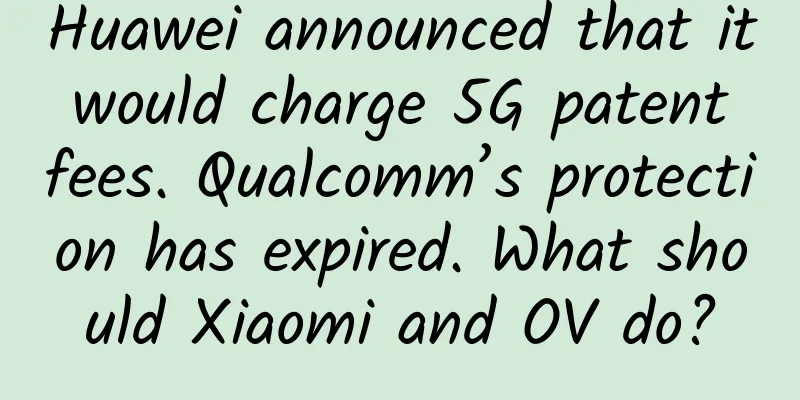Smartphones in 2018: Over the Hill?

|
The winter of 2018 was exceptionally cold. Broken capital chain, shrinking shipments, bankruptcy and reorganization... In the cold wind, China's smartphone manufacturers are shivering. In order to cope with the winter, manufacturers racked their brains, rehashed old ideas, curry favor, piled up configurations, and rushed to be the first to launch. Whether they are leading manufacturers or niche brands, it is a good thing to gain a foothold in the extremely crowded space and strive to expand their territory inch by inch. 2018 was a colorful, intense and dangerous year for China's smartphone industry, and for those who are still alive, the battle continues.
At the end of one's wits In this year's mobile phone war, the screen is an unavoidable battlefield. Notch screens, water drop screens, pop-up screens, perforated screens, and folding screens have come one after another, and in the final analysis, it is everyone's obsession with screen-to-body ratio. Just like Helen to the Trojan War, this obsession has also attracted various manufacturers to continuously iterate on their new products in 2018 with an increase of 0.1%, setting a higher screen-to-body ratio. The iteration method of small steps and fast progress has brought about a wave of frequent new products, but as a result, the number of mobile phone models seems a bit insufficient. In the middle of the year, vivo launched the pop-up camera with a stunning vivo NEX. After that, OPPO, Xiaomi, Honor, Lenovo and others quickly followed suit and released their own models with sliding or pop-up cameras, with screen-to-body ratios that beat the previous notch screen and water drop screen. When this trend gradually subsided, vivo released another new product named "NEX" in Shanghai on December 11 - vivo NEX Dual Screen Edition. The concept of dual-sided screen was not first introduced by vivo. Earlier this year, models such as Russia's YOTA3 series and Hisense A2Pro had already tried the design of LCD screen on the front and ink screen on the back. This is a "mutation" that occurred when the competition in the front screen has become extremely fierce, oh no, it is at the end of the road - directly breaking through the 100% screen-to-body ratio. Back to the vivo NEX dual-screen version, it does not use an ink screen on the back screen, but also uses an LCD screen like the Nubia X. Basically, the functions that can be achieved on the front can also be achieved on the back screen, enabling multi-tasking. In addition, the main contribution of the back screen is reflected in taking pictures, games and the somewhat useless "mood transmission" function. It is undeniable that this dual-screen phone is very cool, but the operation of pressing the side button, turning over to use the back screen, and then pressing the side button again to return to the main screen is indeed a bit beyond the scope and breaks the user's usage habits. And the 3500mAh battery capacity is not enough for two LCD screens, especially for such a model that focuses on new gaming experiences. Punch-hole screens have also quickly become popular. On the evening of December 10, Samsung released its first punch-hole screen phone, the Galaxy A8s, in Beijing; on the same day, Honor also announced that it would release the Honor V20 at the end of December, also using a punch-hole screen design; and recently, news from the Xiaomi industry chain said that Xiaomi will also release a new model using BOE's punch-hole screen in January next year. In addition to double-sided screens and punch-hole screens, more advanced folding screens are also eager to try. When Huawei and Samsung were announcing that they would launch the first folding screen, a domestic screen manufacturer Royole Technology suddenly appeared and launched the folding screen mobile phone "FlexPai" at the end of October. Royole Technology's mid-term surprise exceeded everyone's expectations, but what was not unexpected was that this model is still on pre-sale. A more realistic scenario is that the real competition in the folding screen market will begin next year, and by then it will be time for manufacturers to demonstrate their real technology. As screens get bigger and thinner, the space for batteries is very limited, and it is difficult to increase battery capacity, so everyone has put a lot of effort into charging. From wired charging to wireless charging, from "5 minutes of charging, 2 hours of talk time" to Huawei's 40W super fast charging, and even the reverse charging of the Mate 20, all of these efforts are aimed at solving users' anxiety about power consumption at a time when mobile phones have become a high-frequency daily necessity. However, charging faster is only a temporary solution, and charging less is the real way to solve the user's pain points. At present, the battery paradox still has no solution. In addition to screen and charging, memory has also become a selling point for various companies to compete with each other. In this year, the RAM of smartphones has increased from 4GB to 6GB, 8GB, and then to 10GB and 12GB. On December 18, Lenovo released the Z5 Pro, which uses a 12+512GB combination. In the middle of the year, the RAM of Hammer's Nut R1 went up to 1TB. Looking at Apple's 3GB and 4GB RAM, no Apple users think that the RAM is too small and the system is not smooth. So, with Android models putting so much effort into improving RAM and running scores, do they really not consider fixing more fundamental system issues? In addition to the arms race in hardware, the competition in AI is also becoming more and more intense. In addition to competing in the number of cameras, Chinese mobile phone brands’ photo beautification technology leads the world by continuous breakthroughs in AI algorithms. From "This moment is clearer" and "Photos are clearer" to "Illuminate your beauty" and "Better understand your beauty" and "Idol-level selfie" and "Photos of people are more beautiful" and "High-value selfies love selfies", the evolution of slogans is due to changes in demand. Under the influence of social networking and photo sharing trends, "clarity" can no longer satisfy Chinese consumers. The demands of young consumers now are very straightforward: they want "beauty". Mobile phone manufacturers have also grasped this point. Various cosmetic algorithms make users' selfies more beautiful while ensuring that they are "natural". Thanks to the efforts of mobile phone manufacturers, the interest and demand of Chinese young people in selfies have been further explored. The resonance and mutual stimulation formed by this have made Chinese mobile phone photography and picture beautification technology "far ahead of others". If these PK competitions are all "stacked", then next year's 5G speed war will be much more "hardcore". Thinking of this, I can't help but feel sorry for mobile phone manufacturers. The busy and stressful 2018 has not yet passed, and the 2019 exam paper has already been delivered to them. But from another perspective, it is very lucky to get the next exam paper. After all, several candidates have been asked to leave the exam room this winter. In the fierce competition, whether it is the leading or niche, smartphone manufacturers must and can only do their best to survive. Arm wrestling Gionee went bankrupt, Smartisan was in danger, Meitu was entrusted to Xiaomi, Samsung withdrew from its Tianjin factory, and Apple's sales declined... In less than two months, many changes have taken place in China's smartphone industry, most of which are gloomy. If we look at them as a whole, we can see that the "species diversity" of China's smartphone market has been further weakened - in this process, Huawei, OPPO, vivo and Xiaomi, the four major domestic brands, continue to erode the market, and second-tier and niche brands are either huddling together for warmth, or clinging to thighs, or teetering on the verge of collapse. This is a process, a process of internal reshuffle and overseas expansion of Chinese brands. This year, after establishing their leading position in China, Xiaomi, Huami and OV are unwilling to be outdone in internationalization. The one that made the most noise was Xiaomi. Internationalization is one of the driving forces behind Xiaomi's comeback. Since 2014, Xiaomi has begun to promote its internationalization strategy and has been gradually expanding into emerging markets such as India, Southeast Asia, and Eastern Europe. According to financial reports, Xiaomi's overseas sales in 2015, 2016, 2017, and Q1 2018 were 4.056 billion yuan, 9.154 billion yuan, 32.081 billion yuan, and 12.47 billion yuan, respectively, accounting for 6.07%, 13.38%, 27.99%, and 36.24% of the company's total revenue, respectively. In Q3 of this year, Xiaomi's overseas revenue accounted for 43.9% of its total revenue. Xiaomi has achieved remarkable results in the Indian market in particular. According to a report by Counterpoint Research, in Q3 2018, Xiaomi occupied 27% of the Indian mobile phone market, ranking first, followed by Samsung and vivo, with 23% and 10% respectively. In addition, the European market has also become a new battlefield for Xiaomi. According to data from the China Mobile World Research Institute, Xiaomi achieved the best online sales in Spain and Italy in September this year. Unlike the Indian market, Europe is a relatively mature market where users are very picky about products. Liu Zuohu, founder of OnePlus, once said that it is easy to increase sales in India and Africa, but that is not internationalization. Only after gaining recognition in Europe and the United States can we talk about the global market. Therefore, not only Xiaomi, but also Huawei, OPPO, vivo, OnePlus and others are targeting the European market. OPPO's flagship model Find X was first launched in Paris, France, and it has also announced its entry into the French, Italian, Spanish, Dutch and Russian markets. Online sales account for more than 25% of the European market. In terms of brand positioning, OPPO is also seeking a higher-end image. From Leonardo, the original spokesperson for the Find series, to the Barcelona customized version of R11, to the Neymar and Lamborghini cooperation version of Find X, OPPO's transformation is still continuing. As the only domestic smartphone brand sponsor of the Russia World Cup, this expenditure set a record for vivo's single marketing investment, and also effectively enhanced vivo's international influence and brand awareness. In order to enter the European market, OV has continuously emphasized innovation this year. Find X and NEX have used unique mechanical structures to erase the traces of the iPhone and use products to create a new image that is not tied to labels such as "marketing", "channel" and "follow". In recent years, Huawei's flagship models P series and MATE series have chosen to be launched in Europe first. For Huawei, the European market is second only to China, and it has formed a solid shield here. Since the beginning of this year, Honor has also accelerated its pace of going overseas. At the launch of Honor Magic 2, Honor officially announced the new logo, which became the capitalized "HONOR", and in the Black Friday battle report, it ranked at the top of the list in markets such as France, Germany, the United Kingdom, and Italy. According to Counterpoint data, Honor smartphones achieved a 300% growth rate in the Indian market in April 2018, becoming the fastest growing smartphone brand in the Indian market. The sales of Honor 9 Youth Edition exceeded 1 million units in 90 days after its launch. According to the latest data, Honor smartphones grew 450% year-on-year in the Indian market in 2018, setting a new record. Chinese brands are conquering the Indian market with their cost-effectiveness and entering the European market with their innovative quality. The pace of Chinese brands going overseas is steady and orderly. But the bad news is that according to Canalys data, in the third quarter of this year, the overall sales volume of the Indian smartphone market fell by 1%, which is the second time that the Indian market has shrunk. At the same time, Indian local mobile phone manufacturer Micromax has squeezed into the top five in terms of shipments again, which is due to the support from the government and the patriotic sentiment of Indian consumers. Although it only fell by 1% and is most likely a phased decline, once the signal of shrinkage is sent out, it will form a trend. The story of the blue ocean turning into a red ocean and the incremental market turning into stock market that happened in the Chinese market will happen again in the Indian market. The incremental space of the Indian market is shrinking sharply, the growth rate is slowing down, and consumer sentiment is gradually returning to rationality. For the pioneers who come to make money, it is difficult to predict whether there will be a good harvest or a reshuffle. But thinking about the cold reception of the pioneer Samsung in the Chinese market today, perhaps we can learn a thing or two. In order to prepare for a rainy day, Xiaomi, which has “died” once, has a keener sense of smell this time. Following the large-scale structural adjustment in September this year, Xiaomi recently made another organizational restructuring, reorganizing the sales and service department into the China region and appointing senior vice president Wang Chuan as president of the China region. With the increase in the Chinese market, Xiaomi has a deeper understanding of "keeping to the right path". In addition to efforts in internationalization and brand marketing, leading mobile phone manufacturers have also set their sights on the IoT field. OV's IoT ecological alliance, Xiaomi's industrial ecological chain, Huawei and Honor's layout in smart home products such as color TVs, Lenovo's SIoT, and 360's S-AIoT all indicate that a huge emerging industry has emerged. Smartphone manufacturers, representing China's strength and wisdom, are advancing by introducing new ideas, adhering to the old while creating surprises, and preparing for the future. Over the Hill With the sound of the clarion call, the rapid rise of Chinese domestic mobile phone brands, led by Xiaomi, Huami, and OPPO, has brought a huge impact to both Apple and Samsung. At present, this Chinese mobile phone army is heading to the global battlefield and has achieved good results in India and Europe. At the same time, their performance in the "new retail" with Chinese characteristics is also remarkable, and they are adept at the marketing strategy of combining online and offline. In terms of products, each company's product lines from high-end to entry-level are constantly being improved. From Europe to rural areas, each company has product models that meet consumer needs. The sense of crisis is also in place. New technologies and selling points such as folding screens, multiple lenses, and reverse charging are rushing to the market without stopping. This is a long-dormant explosion. When the direction is right, every step of effort will bring positive feedback. According to Counterpoint data, global smartphone shipments in the third quarter of 2018 were 387 million units, of which Samsung shipped 72.3 million units, with a market share of 19%, ranking first, with a year-on-year decline of 13%; Huawei and Apple ranked second and third, with shipments of 52 million and 46.9 million units, with market shares of 14% and 12%, respectively. Xiaomi ranked fourth with a market share of 9.0%, followed by OPPO, vivo, and Lenovo. In the third quarter of 2018, the market share of total shipments of Chinese mobile phone manufacturers increased by 33%. If this is a group fight, Chinese smartphone manufacturers have become a wolf pack on the global battlefield. Chinese brands are on the offensive and full of energy. Every step they take to get closer to established giants like Apple and Samsung is a milestone worth celebrating. However, even if Apple's sales decline and Samsung disappears in China, the shadow of the giants cannot be ignored. In addition to hardware, what makes Apple's ecosystem truly full and three-dimensional is the software and hardware synergy brought about by the openness of the iOS system. At this year's fall conference, Cook announced that the number of iOS developers worldwide has exceeded 20 million, covering 77 countries. Apple's developers have earned more than $100 billion from the App Store. Now the Apple App Store has 500 million visitors per week, making it the world's largest application market. When we think about the antitrust lawsuit Apple recently faced for its 30% commission on the APP Store, we cannot understand this sentence: You are not paying for the iPhone's hardware, but paying a premium for Apple's iOS software ecosystem and the synergy between software and hardware. The massive number of iOS users has inspired the enthusiasm of tens of millions of developers, and the creativity and technology contributed by developers have enabled Apple users to experience the coolest applications. The super-strong two-sided network effect built by the APP Store has built high walls on both the supply and consumption sides of application software, trapping more than half of the users. It is no wonder that some people say that Apple is essentially a software service company in the guise of a mobile phone. As for Samsung, it is a semiconductor company disguised as a mobile phone company - from SOC chips, NAND, DRAM, OLED screens, CIS, and even batteries, Samsung has it all. In the smartphone industry, it is the only company that can achieve such vertical integration of hardware. With its strong voice in the supply chain, Samsung is still able to control the lifeline of almost all mobile phone manufacturers, including Apple, and has built a moat like the Mariana Trench. Therefore, when we see the data that Samsung and Apple's market share is declining and Xiaomi, Huami, and OV's market share is rising rapidly, we cannot be "complacent" because the control of core technologies still lies elsewhere and the barrier of ecological synergy is difficult to break. The iceberg under the sea cannot be easily moved. The arrival of 5G will be an opportunity to overtake others. Amid a huge wave of phone replacement, dangers and opportunities coexist. Whether the unshakable iceberg will break and whether latecomers can seize the opportunity to ride the wave are the focus of attention on this battlefield. "Huawei is a leader in 4G and will become the leader in the 5G era." Yu Chengdong, who has always been high-profile, is full of confidence in Huawei's performance in the 5G era. Ren Zhengfei also said at the 5G business report meeting of the Shanghai Research Institute, "If our products are well made, we can serve the vast majority of operators in the world, so that we can take the initiative. So when it comes to 5G, we must be determined to take the lead strategically." At 0:57 a.m. on November 30, OPPO successfully made the world's first 5G mobile phone WeChat video call. The people who appeared in the video were engineers from OPPO's six global research institutes, shouting "Hello OPPO, Hello 5G" together. At the 6th China Mobile Global Partner Conference on December 6, vivo disclosed the latest progress in the research and development of 5G mobile phones, and its 5G prototype achieved high-definition mobile video live broadcast for the first time. Xiaomi phones also opened up 5G signaling and data link connections in September this year, and 5G millimeter wave (mmWave) connections were also opened in October. Lei Jun said that he would cooperate with the 5G release rhythm of global operators and launch the officially mass-produced Xiaomi 5G mobile phone in Europe in the first quarter of next year. Lenovo announced the launch of the "5G Ready" mobile phone Moto Z3 in August. The mobile phone can be turned into a 5G mobile phone by connecting the module. Yang Yuanqing said that the 5G module (Lenovo 5G Pass) of Moto Z3, which can serve as a 5G access hub, will also be launched on the market in early 2019. By then, Lenovo will become one of the first manufacturers to provide 5G experience for mobile users. Those who are barefoot are not afraid of those who wear shoes. The challengers from China are gearing up and moving at full speed towards the 5G curve where they have the potential to overtake others. Whether in terms of product innovation, channel expansion, internationalization or new retail, Chinese mobile phone manufacturers are constantly making up for their shortcomings and even showing their strengths. As the 5G wind blows the sails, the battle for domestic manufacturers to break through continues under the huge waves. |
<<: Key points and difficulties of Android advanced/interview
>>: After interviewing more than 50 UI designers, I summarized these job hunting skills!
Recommend
Although whole grains are good, you may mistake them for fine grains! Don’t learn these 6 ways of eating...
Nowadays, many people are pursuing a healthier di...
Actual combat case | 11 steps to build a product data operation system
This article will explain in detail the "11 ...
Android Custom View
Preface The detailed steps of customizing Android...
A complete guide to the 2019 Tik Tok promotion plan, everything you want to know is here!
While TikTok is reaping the benefits, everyone wa...
Chimelong breeds the world's largest population of monkeys
On December 1, Chimelong Safari Park launched the...
Rare! New discovery in the universe
"Misty Binary Stars": Two rare star sys...
[Overseas Ukrainian Beauty Video Blessings] Short video production of foreign beauties holding signs, orders are placed all year round!
The Chaoge Beauty Sign-holding Team under Chaoge ...
13 kinds of excellent app designs not only have design aesthetics, but also track user experience
【51CTO.com Quick Translation】We have always been ...
Is your phone battery life too short? Pay attention to your charging habits
[[438944]] The battery life of a new mobile phone...
Online event promotion planning and solution analysis
For operators, event operation is a very importan...
Are projectors really better for your eyes than TVs? Before buying a projector, just know these 3 things!
There are so many projectors on the market now, n...
The rules for Douyin corporate accounts to achieve 1 million likes!
This article studied 88 brand clients and 5,459 p...
12 money-making lessons that anyone can copy and execute to reveal the secrets of earning a million dollars a year
If you have a skill, that's great. I can teac...
Google Maps major upgrade preview: making maps more user-friendly and more understanding of your needs
At the I/O developer conference that opened early...









